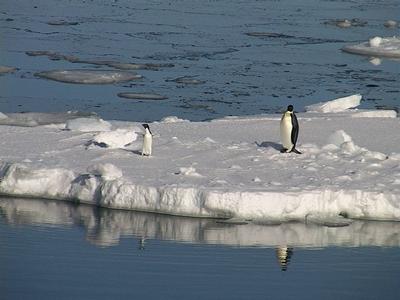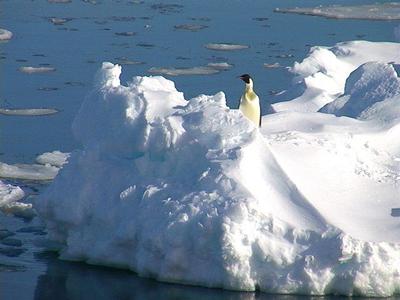
|
|
15 March, 2001
Emperor penguins March 15
-67 08 lat / 062 50 long
How can I write about my experiences in Antarctica without talking about the
emperor penguins? This trip has given us several opportunities to witness
these stately creatures. Glance at the first picture. Can you tell who is
who? The adelie is the little guy with wings out. Now in my video the adelie
is waving it's wings frantically not sure what to do or where to go as this
big orange ship gurgles by. Now look at it's larger counterpart. In the
video neither the expression nor action ever changed. As a matter of fact if
you look at the next picture what do you notice about the "tracks"? Yep, if
you are a good observer you would be able to see that he/she slid towards
us, then stood up to get a better view of the ship going by. There is a huge
difference between the two: the adelie the frantic comic; the emperor true
to it's name, a stately king.
The Emperor Penguin (aptenodytes forsteri) is the world's largest penguin
standing almost 3.3 ft high (1 meter) and weighing between 44 and 88 lbs.
(20 to 40 kg.) They only exist in Antarctica, rarely wandering north of the
Antarctic convergence. The emperor breeds on ice shelves and fast sea ice.
The females lay their egg just as the winter season begins. The males are
actually the ones who take care of the egg while the female returns to the
ocean to feed. The males hold the egg on their feet and cover it under a
fold of feathered skin. Incubation lasts around 66 days during which the
male fasts (doesn't eat). By the time the female comes back, the male will
have lost up to 1/3 to 1/2 of his body weight. If you include the time that
they also don't feed during courtship, fasting can extend 4 months!
Temperatures during the winter can get to -40 degrees centigrade. The males
huddle together to reduce heat loss. Chicks hatch just as the females come
back to relieve the males of their parental duties. The males can finally
leave to feed but not without one last obstacle: the long trek across the
fast ice to the ocean's edge. Depending on the winter this could be tens of
miles! If the chick hatches before the female returns, the males can draw on
reserved food (a crop secretion containing fat and protein) to feed the
chick. Both parents then take turns at parenting duties until the chick is
old enough to be left in creches (day care). As with all Antarctic animals,
due to the short summer season, the chicks grow rapidly and by January they
are ready to join the adults to feed in preparation for the next winter
season.




Contact the TEA in the field at
.
If you cannot connect through your browser, copy the
TEA's e-mail address in the "To:" line of
your favorite e-mail package.
|
